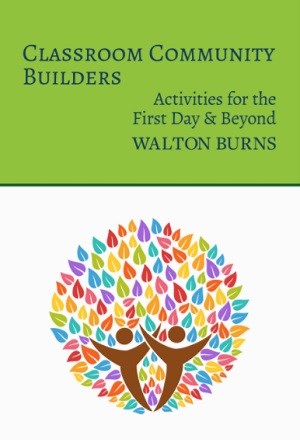Classroom Community Builders, Alphabet Publishing

Classroom Community Builders: Activities for the First Day and Beyond
Walton Burns
Alphabet Publishing
According to Burns, this is ‘a collection of activities that build community in the classroom while students learn’.
Walton also wrote 50 Activities for the First Day at School and this book is a reaction to some comments he received after his first book came out.
I love that he did that! I also love that there are free worksheets you can access at http://www.alphabetpublishingbooks.com/free-classroom-community-builderactivities/.
While the majority of his ideas were not new to me, it was nice to see them all in one place as a reminder and I think this would be an excellent book to recommend to teachers on a foundation teacher training course.
Each activity gives an approximate time limit for the task as well as the language point it focuses on.
The book is organised into six parts, Set Your Expectations, Working Together, Getting to Know You Activities, Get to Know Your Teacher, Tips for Building Community and Considerations for Grouping Students.
In Set Your Expectations, Walton Burns talks about the need for respect and safety where everyone is accepted and welcomed.
He suggests different activities to provide the opportunity for students to explore their textbook and the syllabus and to set classroom rules.
In the activity Classroom Rules Negotiation, he suggests eliciting typical classroom rules from the students through pair and group work and then adds a twist where students discuss unreasonable rules and also vote on consequences if rules are broken.
Another activity I liked, My Favourite Teacher, gives us the opportunity to hear what students expect from us.
The activity is based on a discussion of the things past teachers did and did not do! A further activity compares good teachers and good students. Lots of similarities there I would imagine.
The section on Working Together is really the heart and soul of the book. Here, Walton focuses on activities which foster team work and togetherness.
Among other tasks, it includes note taking, pair sharing, classroom discussion and poster making.
The first activity I paused on is called I am a Word. Students are each given a card with a word on it.
They must arrange themselves with the various words to make a sentence that is grammatically correct and with the correct word order.
This is a take on having students line up according to height or birthdates and could also be used to put students into new groups. The next one that caught my eye is called Fill in the Picture. This is a lovely way to do an information gap.
One student is given half of a picture and the other student is given the other half.
They must describe their picture to their partner to draw … they then compare them.
While the example given in the book is of a cartoon, this could also be done with a photograph or a picture from a magazine.
Prepositions of place and descriptors would easily fit in here as a language point.
Culture Shock was a task used to introduce hedging and opinion giving Students are given a list of questions to discuss.
For example, would students give up their seat to someone on the bus or disagree with older people? These would work really well in a mixed class, but the more controversial ones might bring up some uncomfortable feelings. For example, asking people about their religion.
There was also a scavenger hunt activity where students are meant to explore their classroom to find clues hidden around the room.
These clues would eventually lead to a question to discuss or something to read, etc.
The section on Getting to Know You was full of the old standards (Find someone who …, etc.) but the next section, Get to Know Your Teacher was more intriguing.
These activities allow the students to ask you about, well, you! The teacher can set parameters if s/he chooses to and can either do the tasks at the beginning of the class or a few minutes every day.
Just having come off teaching a CELTA, I know that our teaching practice students and the trainees were curious about us, the trainers.
Everyone wants to connect and as we break down the teacher/student walls, it is a natural phenomenon to have conversations where you divulge some information about yourself. Ask the Teacher was just this kind of activity.
In the final pages of the book, Walton provides sage advice on how to work with students who are being culturally insensitive to one another and advises teachers to be strict and set down firm ground rules with any student showing disrespect to another student.
Emotional safety is paramount in a classroom and his tidbits of advice focus on this.
The last section is basically advice to the novice teacher.
I enjoyed this book. Being a visual learner, I would have responded even better had there been some colour or pictures; however, keeping everything black and white does help to make it more affordable.

Comments
Write a Comment
Comment Submitted